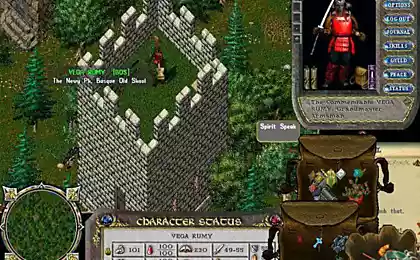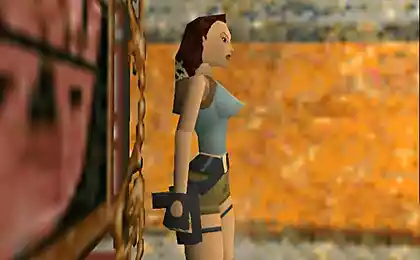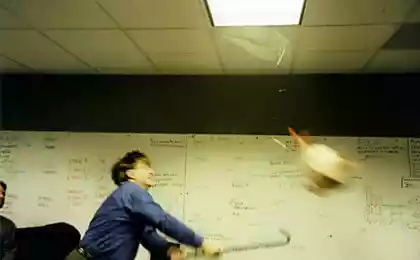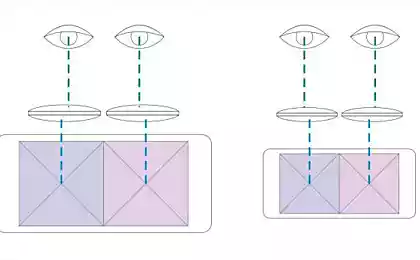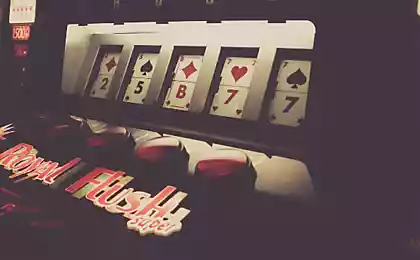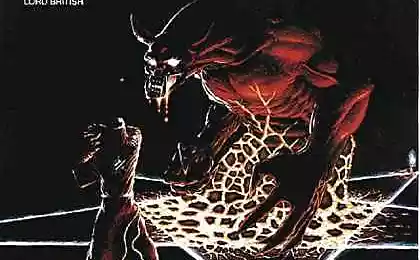History checkers (in graphics)

- Evolution? - Chief brightened. - Something new?
- French fiction. I tried to understand this. If, for example, take the earthworm and instead just slip the African rhinoceros, then everyone will see that they are cheated. But if the same trick a long stretch, then no one will notice.
That's the whole thing: who saw the worm - all long povymerli and who met rhino - once to talk about all sorts of trivia.
Eugene Chemerevsky & quot; Variations on turtle & quot; i>
It always happens when than interested. The more you learn, the more there is an opportunity to learn something new. Then an endless stream of the most sweeping you with brand new head, and you start to sink. But as long as this did not happen - life is beautiful.
I want to talk about than to know almost everything. About what few people interested. The fact, as almost no one knows anything. I want to talk about Checkers . Do not rush to smirk. If you think you know everything about Checkers answer (for me) a few simple questions:
What kinds of Checkers there? What is the difference Checkers from chess? What do the Checkers and "Tic Tac Toe»?
I was always interested in logic games, but a variety of all kinds of regulations attracted me more than the game itself. True base material pumped. Judge for yourself, you play with someone (yes, though with yourself) in Checkers or Chess is not difficult. Board and sets of figures are sold in any specialty store. With Shogi or Syantsy more complicated. The shops do not find these games (at least here in the boonies), and their own limbs, quite frankly, are more suited for pressing the buttons than for wood.
Of course, in our time, for almost any game you can find a computer program. Key words in this phrase exactly two - Find and almost ZoG . Yes, it is not very good at chess, but it allows you to program virtually any game on their own (what many did not hesitate to use the ) . Stumbling on the Klondike desktop igrostroya I unwittingly became interested in logic games (including the history of their development) more seriously.
Long or short, but after a long reel of Wikipedia and thematic forums, I came across a great blog Дмитрия Skiryuka . It's funny that I came to this blog in the search for a clear description of some medieval game called Ritmomahiya . This is what, in this regard, written by Dmitry:
... Ritmomahiya confess that I was interested. I started to dig in this direction, and frankly, not very succeeded, but stumbled on the trail that led me to the Chase ... blockquote> Well, as I said, if you are looking for something, you often do not find it was looking for. But I met with the "Chase." I have to say, posting descriptions of the game in the topic "History of checkers" puzzled me. For a start, I realized that I almost do not know anything about checkers. This, however, is not surprising. As probably most of my countrymen I know about checkers since childhood, but, at the same time, have never considered this game as something serious (such as, for example, Chess).
I confess, I was wrong ... Thematic блог Dmitry has provided enough material to think about it. And then I noticed that almost all of the games mentioned are Dmitry ZoG implementation. Thus was born the idea of a review on the history of Checkers. Of course, my review is secondary. I rely heavily on the extensive material collected Dmitry Skiryukom and ask to consider my post only as an illustration of his gigantic work done.
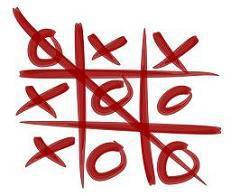
Let's start ...
I think that, from the reading of this post, it will be difficult to find a man never to play "Tic Tac Toe." Of course, you say, but what does this have to Checkers? Let's not be hasty. Thus, the "Tic Tac Toe." Simple rules available "inventory" ... In this great game has only one drawback - the game with the correct sides of it always (and very fast) ends in a draw. It is very boring, because what is completely absent or intrigue. As a result, this game (clock) can play razve that younger students.
Of course, there have been repeated attempts to make the game more interesting. I personally know of two fundamentally different approaches to uslozhneneniyu this game (actually more, but more on that later). Firstly, it is possible to increase the size or dimension of the board. Thus, it is possible to play 3D, 4D or гексагональной a blackboard or a whiteboard большого size. Of course, on a large board does not make sense to play the game, "three in a row." That game was interesting needed to build a row of five chips. Adding to this neckolko rules to correct the balance of the game, we get Renju :
Unlike its ancestor, Renju is quite "adult" game. As it has training literature, hosts international championships. But the increase in the size of the board is not the only way to complexity of the game. Instead of increasing the size of the board can be moved to allow the chips. At the beginning of the game, players can put them on the board as well as in the "Tic Tac Toe", but having exhausted the allocated limits chips (and get on board the law-governed drawn position) players can begin to move pieces on the board, with the aim of building the line "3 in a row ". Perhaps initially, the game was on the 3x3. It is in this form of the game called "Dance of the 3 men" described in the book Martin Gardner « Math Puzzles & Entertainment » .
It's more fun to play than the "Tic-Tac-Toe", but it can be made even more interesting. First, you can increase and complicate the playing field, to give players more than 3 chips and, most importantly, change the condition of victory. Putting a line of 3-chip player does not win, and is entitled to remove from the field any token opponent. The goal - to remove all chips from the board of the opponent. That's what the game "Dance 9 Men", also known as & quot; Мельница". Options for playing fields for the "mill" is very diverse . Here is a party game in the & quot; Мельницу" on one of these boards:
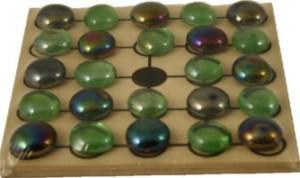
Like any other story, the story Checkers could not do without the Egyptians. It was invented in Egypt game called Seega . Although this game is not very popular, it has survived to the present day. Thus, it is likely the most ancient version of "clamping sticks", the rules of which we are known. The Greeks and Romans also contributed to the development of the game of checkers, inventing games & quot; Petteyya & quot; and & quot; Latrunculi & quot ;, sootvetvenno. Without a doubt, these games there, but unfortunately, their rules almost nothing is known. Some researchers believe that the "siege" is derived from "Petteyi", but also in the firm belief there.
All these games are a metaphor of fighting, typical for that time. Each player has a set of similar figures (their color) and could move them around the board, in accordance with the rules. Figure opponent removed from the board (at least in the "siege") after the "pinching" on both sides (vertically or horizontally) with their figures (two soldiers won the battle of). The "siege" The game starts with exhibiting pieces on the board (as in "Mill"). Just putting all your pieces players could start to move them one square vertically or horizontally. Here's how to это It looks:
Another game, "clamp" type, extant, is a Japanese Hasami Shogi . This game, on the right, may be called "Japanese swords." Removal of opponent's pieces off the board, and shall be performed by "pinching" on both sides (which is reflected in the title game Hasami - «ticks"), but "clamping" may be not one but several pieces at once (there are also complicated rules "pinching "figures in the corner of the board, you can see that in the next video ). The figures can not go to one, but several cells at once (as a Rook in Chess). It is interesting that the purpose of the game is not the removal of the board of all the pieces of the enemy. In various embodiments, for the win, or you want to remove from the board 5 opponent's pieces, or (greetings from "Tic Tac Toe") put 5 of his pieces in a row. I must say that all these rules are for the benefit of the game, making it much more dynamic than, for example, Seega:
By the same "clamping" principle is based Tibetan game Gundru, also known as & quot; Minh Mang & quot ;. Just as in Hasami Shogi, «clamped" can be several pieces at once, but the captured pieces are not removed from the board and changing color (just flipped chips):
At the end of the video you can see, how a player can bring the party to a draw. Unfortunately, this tactic is possible for all games "clamp" type, whose purpose is to capture all opponent's pieces. However, this does not make the game less interesting. Connoisseurs of board games certainly have noticed the similarity of the principles of the game with another game:
Unlike the games mentioned above, & quot; Reversi & quot; This game is relatively young, with a complex fate. It was invented in Britain in the late XIX century, but later forgotten, due to the social upheavals beginning of XX century. In 1971, it was revived in Japan under the name of "Othello».

But back to our story. After the Greeks and Romans, contribute to the development of board games have made the Vikings. Making their raids, they spread throughout the world "Bones," "Mill», Шатрандж…
But there was another game. In 1880, in one of the burial mounds it was discovered a fragment of the board, marked up with both sides. One side is designed for the game of "mill", the other - unknown to the game on the field of 13x13 cells. It was found several boards for this game, but the rules remained unknown. Perhaps those they would have stayed and still if it were not blogs Carl Linnaeus . In 1732, in Lapland, he discovered the game that subsequently failed to link with the findings made.
Although exactly recreate the rules of all the games the family tafl and failed, of course, that they were treated to games, "clamp" type. Unlike games mentioned hereinbefore tafl is not symmetrical game. The aim of one of the players "to defend" the conclusion is the figure of the King "of the environment." Another player - to block it, "holding" his figures with two or more parties (here reconstructions are different interpretations of the rules). Taking "ordinary" shapes made "pinching" them figures from both sides of the enemy, but such destruction figures is not the goal of the game for any of the players. Interested in the history and rules of tafl I again I refer blog Dmitry Skiryuka, adding from itself, an example of one such party games:

The above games are games of "clamping" type. But when taking the figure was carried jump over opponent's piece? There is another game , formerly very popular in the Middle Ages. On the field, reminiscent of a board for game in a "mill" 13 or more "geese" (depending on the version of the game) have to lock (make it impossible to move) a "fox." "Geese" anymore, but the possibility of their travel is limited (they can go one step only vertically or horizontally). "The Fox", in addition, can walk diagonally and also can "eat" the geese at shashechnym rules by jumping over the enemy piece. Even allowed the chain takes! It is, indeed, very similar to modern Checkers!
Although the game "Fox and Geese" is very interesting, historically, in my opinion, it is somewhat nudnovato. The process of locking the "foxes" can last for a very long time. I like a different game, very similar to the board. Nine fields in it, specially selected and are a "fortress". In the fortress there are 2 guards, whose purpose - do not allow attackers to take all of the "fortress." The guards may have hitters as well as "fox" in the game "Fox and Geese". The attackers can move in any direction, the direction of the "fortress." Here's how it looks:
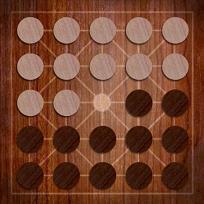
The next milestone in the development of Spanish Checkers became "Alkuerk." This game was played on the field of play "Al Kirkat", borrowed from the Arabs, and is (most likely) version of the "Mills". The move allowed on marked lines. It's not obvious at first glance, but this field is not the same board. Some have eight neighbors, and some of all four. This feature makes the game a very unique, tactically. From the arrangement of the figures, it is evident that the player making the second course is advantageous. The problem with this imbalance is usually solved by holding seriii games with a fairly complex system scoring . Unfortunately, we do not know the details of the rules of the game (whether taking mandatory if allowed to go back, if the conversion occurred figures), but it has lots of renovations.
Alkuerk While not perfect, in the game plan, it is an important transitional stage in the history of Checkers. Because this game was spaced Spaniards around the world, a lot of it modifications . The most obvious solution to the imbalance of the original game was to increase the size of the playing field. So there Harbaga and large size Zammit (in this game are already present "long-range" Kings):
Simply increasing the size - not the only option changes the board. By analogy with the "Mill" was coined by an incredible variety of not-square boards to play by the rules Alkuerka. These games are found in India, America, Africa and Asia combined conditional term «war» Game :

Another approach was the complexity of the rules. For example, in a double, the preservation of which we also have to Lapps, have been added to the figure "Prince" and "The King." These figures, in contrast to the "soldiers" who went forward only could go in any direction, and "is" at will. In addition, these figures are "immune" to the ordinary "soldiers". "King" could take only the enemy "king", "prince" - "king" or "prince." I do not think that this decision was a very good idea, but the game was quite interesting:
In terms of territorial isolation, any more bizarre and gaming systems on the basis of Alkuerka. National pride residents of Madagascar, for example, a Фанорона, characterized by a very original way of taking the figures. There are two ways to take - attack and retreat. With the capture of the attack, the player moves one of his stones at some point so that the next point on the same line is occupied by enemy stone, with stone and all the enemy located him the stones of the same color are removed from the board. When the capture of the retreat, the player moves one of his stones at some point so that the previous point on the same line is occupied by enemy stone, thus, removed from the board as a continuous chain of opponent's stones. Perhaps it is easier to show:
No less interesting is the game the inhabitants of the island of Java.
href="http://ru.wikipedia.org/wiki/%D0%A2%D1%83%D1%80%D0%B5%D1%86%D0%BA%D0%B8%D0%B5_%D1%88%D0%B0%D1%88%D0%BA%D0%B8">турецкие, армянские
href="http://ru.wikipedia.org/wiki/%D0%A8%D0%B0%D1%88%D0%BA%D0%B8#.D0.9C.D0.B5.D0.B6.D0.B4.D1.83.D0.BD.D0.B0.D1.80.D0.BE.D0.B4.D0.BD.D1.8B.D0.B5_.D1.88.D0.B0.D1.88.D0.BA.D0.B8">увеличение href="http://www.zillions-of-games.com/cgi-bin/zilligames/submissions.cgi?do=show;id=882">вертикальные"







